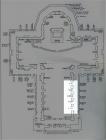3
Iconography of Saint LukeSaint Luke the Evangelist
This particular stained glass window refers to tradition that St. Luke painted the first image of the Virgin Mary and the child Jesus.
St. Luke, beloved physician of St. Paul and the author of the third Gospel.
St. Luke is considered the patron saint of painters and artists. St. Luke's association of artists goes back to the vivid portrait of the Virgin Mary that is contained in his Gospel. Luke showed himself as an artist with words. This led to the belief that Our Lady had allowed herself to be painted by St. Luke.
St. Luke its always represented by the calf or ox, the sacrificial animal, because his Gospel begins with the account of Zachary, the priest, the father of John the Baptist and to the reference of the sacrifice in the Temple at the beginning of his Gospel.
ST LUKE THE EVANGELIST Feast: October 18
5
Iconography of the TransfigurationThe Transfiguration
The Transfiguration of Jesus is an event reported by the Synoptic Gospels in which Jesus is transfigured upon a mountain (Matthew 17:1-9, Mark 9:2-8, Luke 9:28-36). Jesus becomes radiant, speaks with Moses and Elijah, and is called "Son" by God. The transfiguration put Jesus above Moses and Elijah, the two preeminent figures of Judaism.
The images in the stained glass are of Jesus Christ, Elijah, Moses St. Peter, St. James, and St. John. The story is recounted in the Matthew 17, Mark 9 and Luke 9.
Jesus Christ is larger than the other figures to give him prominence, since he is the main figure of the Transfiguration. At his left is Elijah and at his right is Moses (carrying the Ten Commandments).
The stained glass invites the viewer to participate in the event of the Transfiguration by allowing the light coming from Christ in the center of the window.
The rays of light that emanate from Christ were done in a stained-glass style that reflects the shape and colors of the stained glass found elsewhere in the church.
Feast Day: August 6
7
Iconography of Saint Joseph with ChildSaint Joseph with the Child Jesus
A White Lily or One or Three White Flowers. The whiteness of the flower represents Joseph's virtue, holiness, innocence, and obedience to God: he did as the angel commanded (Mt 1:24; see also Mt 2:14, 21, 22). The white flower also represents his faithfulness to Mary, as well as his chastity and sexual purity because he respected her virginity and remained celibate throughout their marriage: he had no relations with her (Mt 1:25a).
A Flowering Staff. There are a number of non-scriptural texts that describe Joseph as the one especially chosen by God to be the husband of Mary. The imagery is drawn from an incident when Aaron's staff sprouted with almond blossoms as a sign that he was especially chosen by God (Num 17:23).
The Child Jesus. St. Joseph is frequently depicted with the young child Jesus to represent his role as the father of Jesus (Lk 3:23; 4:22; Jn 1:45; 6:42). Joseph served as Jesus' guardian and protector, especially during their travels. He also provided for Jesus, cared for him, and instructed him.
Saint Joseph is considered the patron saint of carpenters and of those on their deathbed.
The Feast Day of Saint Joseph, Husband of the Blessed Virgin Mary is on March 19th
The Feast Day of Saint Joseph the Worker is on May 1st
9
Iconography of The AnnunciationThe Annunciation
Mary in response to the angel's message is often shown reading or in prayer, often while kneeling near a volume of scripture. Sometimes the volume is open to Isaiah's prophecy that a virgin will conceive and bear a child.
Annunciation images include a light that shines down from heaven in the direction of the Virgin.
A dove flies down on this light or will hover above her head representing the Holy Spirit and referring to the line in the Nicene Creed that states, "by the power of the Holy Spirit He became Man."
The angel Gabriel is seen in the left half of the image, a branch of lilies, symbolizing the purity of Mary.
The Annunciation has always been celebrated on March 25, exactly nine months before Christmas Day.
11
Iconography of Saint CeciliaSaint Cecilia
Saint Cecilia, Virgin and Martyr - late 2nd or 3rd Century
Cecilia, the patron saint of musicians and church music, was arrested for setting up her home as a church. Her association with music rests on a legend that she praised God and sang to Him as she lay dying.
In stained glass and art St. Cecelia is pictured with musical instruments such as drums, harps or viols. In this stained glass she is holding a portative pipe organ.
Her preference for heavenly song is expressed in her heavenward glance
Feast day: November 22





